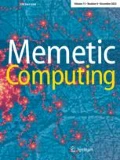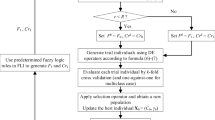Abstract
In this paper, a novel fuzzy support vector machine (FSVM) coupled with a memetic particle swarm optimization (MPSO) algorithm is introduced. Its application to a license plate recognition problem is studied comprehensively. The proposed recognition model comprises linear FSVM classifiers which are used to locate a two-character window of the license plate. A new MPSO algorithm which consists of three layers i.e. a global optimization layer, a component optimization layer, and a local optimization layer is constructed. During the construction process, MPSO performs FSVM parameters tuning, feature selection, and training instance selection simultaneously. A total of 220 real Malaysian car plate images are used for evaluation. The experimental results indicate the effectiveness of the proposed model for undertaking license plate recognition problems.

















Similar content being viewed by others
References
Anagnostopoulos CNE, Anagnostopoulos IE, Psoroulas ID, Loumos V, Kayafas E (2008) License plate recognition from still images and video sequences: a survey. Intell Transp Syst IEEE Trans 9(3):377–391
Shan D, Ibrahim M, Shehata M, Badawy W (2013) Automatic license plate recognition (ALPR): a state-of-the-art review. Circ Syst Video Technol IEEE Trans 23(2):311–325
BBC News Channel (2005) CCTV network tracks getaway car [cited 12 Feb 2015]. http://news.bbc.co.uk/2/hi/uk_news/england/bradford/4455918.stm
Emirates 24|7 News Channel (2014) Dubai Police start to use Google Glass. [cited 12 Feb 2015]. http://www.emirates247.com/news/emirates/dubai-police-start-to-use-google-glass-2014-10-27-1.567748
Kim K, Jung K, Kim J (2002) Color texture-based object detection: an application to license plate localization. In: Lee SW, Verri A (eds) Pattern recognition with support vector machines. Springer, Berlin, Heidelberg, pp 293–309
Yao Z, Yi W (2014) License plate detection based on multistage information fusion. Inf Fusion 18:78–85
Jin-Tsong J (2005) Hybrid approach of selecting hyperparameters of support vector machine for regression. Syst Man Cybern Part B Cybern IEEE Trans 36(3):699–709
Steinwart I (2003) On the optimal parameter choice for v-support vector machines. Pattern Anal Mach Intell IEEE Trans 25(10):1274–1284
Viola P, Jones M (2001) Rapid object detection using a boosted cascade of simple features. In: IEEE computer society conference on computer vision and pattern recognition, vol 1, pp 511–518
Guo XC, Yang JH, Wu CG, Wang CY, Liang YC (2008) A novel LS-SVMs hyper-parameter selection based on particle swarm optimization. Neurocomputing 71(16):3211–3215
Huang C-L, Dun J-F (2008) A distributed PSO-SVM hybrid system with feature selection and parameter optimization. Appl Soft Comput 8(4):1381–1391
Lin C, Ying K, Chen S, Lee Z (2008) Particle swarm optimization for parameter determination and feature selection of support vector machines. Expert Syst Appl 35(4):1817–1824
Sudheer C, Maheswaran R, Panigrahi B, Mathur S (2013) A hybrid SVM-PSO model for forecasting monthly streamflow. Neural Comput Appl 24(6):1381–1389
Wang H, Zhao G, Li N (2012) Training support vector data descriptors using converging linear particle swarm optimization. Neural Comput Appl 21(6):1099–1105
Batuwita R, Palade V (2010) FSVM-CIL: fuzzy support vector machines for class imbalance learning. Fuzzy Syst IEEE Trans 18(3):558–571
Chun-Fu L, Sheng-De W (2002) Fuzzy support vector machines. Neural Netw IEEE Trans 13(2):464–471
António C (2014) A memetic algorithm based on multiple learning procedures for global optimal design of composite structures. Memet Comput 6(2):113–131
Raeesi NM, Kobti Z (2012) A memetic algorithm for job shop scheduling using a critical-path-based local search heuristic. Memet Comput 4(3):231–245
Nekkaa M, Boughaci D (2015) A memetic algorithm with support vector machine for feature selection and classification. Memet Comput 7(1):59–73
Ni J, Li L, Qiao F, Wu Q (2013) A novel memetic algorithm and its application to data clustering. Memet Comput 5(1):65–78
Goldbarg M, Asconavieta P, Goldbarg E (2012) Memetic algorithm for the traveling car renter problem: an experimental investigation. Memet Comput 4(2):89–108
Chia J, Goh C, Tan K, Shim V (2011) Memetic informed evolutionary optimization via data mining. Memet Comput 3(2):73–87
Cortes C, Vapnik V (1995) Support-vector networks. Mach Learn 20(3):273–297
Sutton RS, Precup D, Singh S (1999) Between MDPs and semi-MDPs: a framework for temporal abstraction in reinforcement learning. Artif Intell 112(12):181–211
McPartland M, Gallagher M (2011) Reinforcement learning in first person shooter games. Comput Intell AI Games IEEE Trans 3(1):43–56
Sharma R, Spaan MTJ (2012) Bayesian-game-based fuzzy reinforcement learning control for decentralized POMDPs. Comput Intell AI Games IEEE Trans 4(4):309–328
Watkins CCH, Dayan P (1992) Q-learning. Mach Learn 8(3–4):279–292
Rakshit P, Konar A, Bhowmik P, Goswami I, Das S, Jain L, Nagar A (2013) Realization of an adaptive memetic algorithm using differential evolution and q-learning: a case study in multirobot path planning. Syst Man Cybern Syst IEEE Trans 43(4):814–831
Kennedy J, Eberhart R (1995) Particle swarm optimization. In: IEEE International Conference on Neural Networks. Perth, WA
Zhi-Hui Z, Jun Z, Yun L, Chung H (2009) Adaptive particle swarm optimization. Syst Man Cybern Part B Cybern IEEE Trans 39(6):1362–1381
Lim WH, Mat Isa NA (2013) Two-layer particle swarm optimization with intelligent division of labor. Eng Appl Artif Intell 26(10):2327–2348
Lim WH, Mat Isa NA (2014) Teaching and peer-learning particle swarm optimization. Appl Soft Comput 18:39–58
Lim WH, Mat Isa NA (2014) Particle swarm optimization with increasing topology connectivity. Eng Appl Artif Intell 27:80–102
Zhi-Hui Z, Jun Z, Yun L, Yu-hui S (2010) Orthogonal learning particle swarm optimization. Evol Comput IEEE Trans 15(6):832–847
Gao M, Hong X, Chen S, Harris C (2011) A combined SMOTE and PSO based RBF classifier for two-class imbalanced problems. Neurocomputing 74(17):3456–3466
Xia H, Sheng C, Harris CJ (2007) A kernel-based two-class classifier for imbalanced data sets. Neural Netw IEEE Trans 18(1):28–41
Caner H, Gecim HS, Alkar AZ (2008) Efficient embedded neural-network-based license plate recognition system. Veh Technol IEEE Trans 57(5):2675–2683
Bo L, Bin T, Ye L, Ding W (2013) Component-based license plate detection using conditional random field model. Intell Transp Syst IEEE Trans 14(4):1690–1699
Zhou W, Li H, Yijuan L, Qi T (2012) Principal visual word discovery for automatic license plate detection. Image Process IEEE Trans 21(9):4269–4279
Agarwal S, Awan A, Roth D (2004) Learning to detect objects in images via a sparse, part-based representation. Pattern Anal Mach Intell IEEE Trans 26(11):1475–1490
Zhen J, Huilian L, Yiwei W, Wu Q (2007) A novel intelligent particle optimizer for global optimization of multimodal functions. In: IEEE congress on evolutionary computation. Singapore
Pan Q-K, Fatih Tasgetiren M, Liang Y-C (2008) A discrete particle swarm optimization algorithm for the no-wait flowshop scheduling problem. Comput Oper Res 35(9):2807–2839
Wang C-H, Lin T-W (2011) Improved particle swarm optimization to minimize periodic preventive maintenance cost for series-parallel systems. Expert Syst Appl 38(7):8963–8969
Bishop CM (1995) Neural networks for pattern recognition. Oxford University Press, Oxford Inc
Friedman N, Geiger D, Goldszmidt M (1997) Bayesian network classifiers. Mach Learn 29(2–3):131–163
Aha D, Kibler D, Albert M (1991) Instance-based learning algorithms. Mach Learn 6(1):37–66
Han H-G, Qiao J-F (2013) A structure optimisation algorithm for feedforward neural network construction. Neurocomputing 99:347–357
Efrorn B, Tibshirani RJ (1993) An introduction to the bootstrap. Chapman and Hall, London
Efron B (1979) Bootstrap methods: another look at the jackknife. Ann Stat 7(1):1–26
Pham D, Ghanbarzadeh A, Koc E, Otri S, Rahim S, Zaidi M (2005) The bees algorithm. Technical note. Manufacturing Engineering Centre, Cardiff University, UK, pp 1–57
Kim JH, Loganathan GV (2001) A new heuristic optimization algorithm: harmony search. Simulation 76(2):60–68
Mirjalili S, Mirjalili S, Hatamlou A (2015) Multi-verse optimizer: a nature-inspired algorithm for global optimization. Neural Comput Appl 27(3):495–513
Mirjalili S, Mirjalili SM, Lewis A (2014) Grey wolf optimizer. Adv Eng Softw 69:46–61
Hiromoto M, Sugano H, Miyamoto R (2009) Partially parallel architecture for adaboost-based detection with haar-like features. Circ Syst Video Technol IEEE Trans 19(1):41–52
Wang Q, Yan P, Yuan Y, Li X (2013) Multi-spectral saliency detection. Pattern Recognit Lett 34(1):34–41
Naqvi S, Browne WN, Hollitt C (2016) Salient object detection via spectral matting. Pattern Recognit 51:209–224
Chen S, Liu C (2015) Eye detection using discriminatory Haar features and a new efficient SVM. Image Vis Comput 33:68–77
Park K-Y, Hwang S-Y (2014) An improved Haar-like feature for efficient object detection. Pattern Recognit Lett 42:148–153
Vural S, Mae Y, Uvet H, Arai T (2012) Multi-view fast object detection by using extended haar filters in uncontrolled environments. Pattern Recognit Lett 33(2):126–133
Yan J, Li J, Gao X (2011) Chinese text location under complex background using Gabor filter and SVM. Neurocomputing 74(17):2998–3008
Paisitkriangkrai S, Chunhua S, Zhang J (2008) Fast pedestrian detection using a cascade of boosted covariance features. Circ Syst Video Technol IEEE Trans 18(8):1140–1151
Author information
Authors and Affiliations
Corresponding author
Rights and permissions
About this article
Cite this article
Samma, H., Lim, C.P., Saleh, J.M. et al. A memetic-based fuzzy support vector machine model and its application to license plate recognition. Memetic Comp. 8, 235–251 (2016). https://doi.org/10.1007/s12293-016-0187-0
Received:
Accepted:
Published:
Issue Date:
DOI: https://doi.org/10.1007/s12293-016-0187-0




